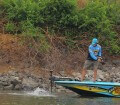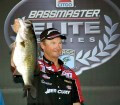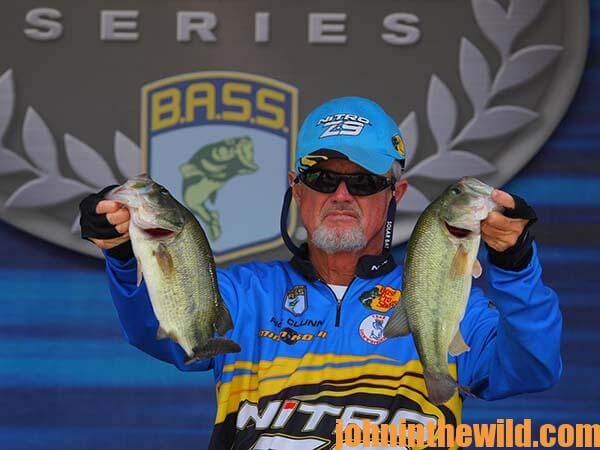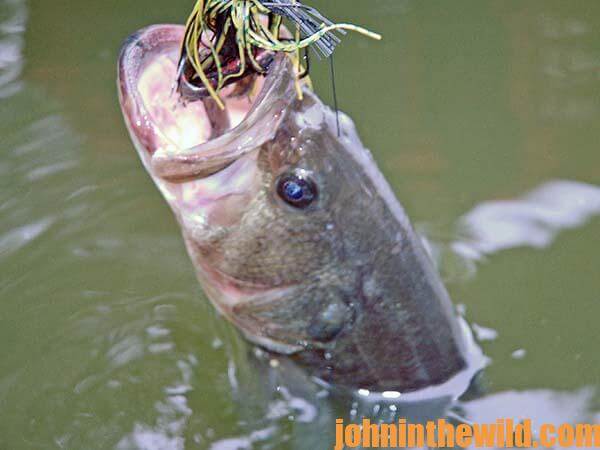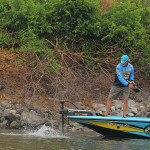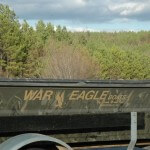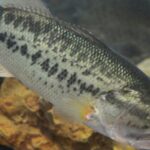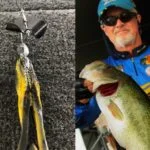John’s Note: This year 2013 anglers have experienced about every type of bad weather affecting much of the nation, particularly rain, floods and rising water. Outdoor writer John E. Phillips has talked with some of the tried-and-true bass fishermen who must catch fish no matter what the weather is. Rick Clunn www.rickclunn.com, a professional bass fisherman from Ava, Missouri, has won the Bassmaster Classic tournament 4 times, tying him with Kevin VanDam for most wins, and has been Angler of the year. Clunn is considered one of the best anglers of all time, having placed in the top 10 in over 100 tournaments and winning 17 of those. Clunn also has been inducted into the Bass Hall of Fame. Here are some of Rick Clunn’s tactics for finding bass in falling waters.
“When the water begins to fall, bass become very concentrated,” Rick Clunn says. “Falling water is my favorite  fishing situation. When a lake falls, there is less water for the fish to be in and less water for the angler to have to fish to try and find them.”
fishing situation. When a lake falls, there is less water for the fish to be in and less water for the angler to have to fish to try and find them.”
Fish Points:
According to Clunn, “Another truth I have found is a little rhyme I heard some place, ‘Falling water points fish out.’ This rhyme simply means that if you have found bass in pockets and coves before the lake starts to fall, the bass will move to the points during the falling water. The fish will leave the shallows and move down the point toward deeper water and safety. Therefore, your best fishing should be along points that come out of shallow-water pockets. Knowing where the bass are positioned on the points is another important key to catching the bass. I have discovered that the fish prefer the most-vertical side of the point when the water is falling. They want to move to deep water quickly, if the water level continues to come down. By staying next to the deepest side of the point, they seem to feel more secure. To locate and catch these falling-water bass, I prefer to use a medium or deep-diving crankbait. Although many fishermen believe the color of the crankbait they use is important, I don’t. Your best rule of thumb is to utilize the color that you have the most faith in – no matter what that color is.
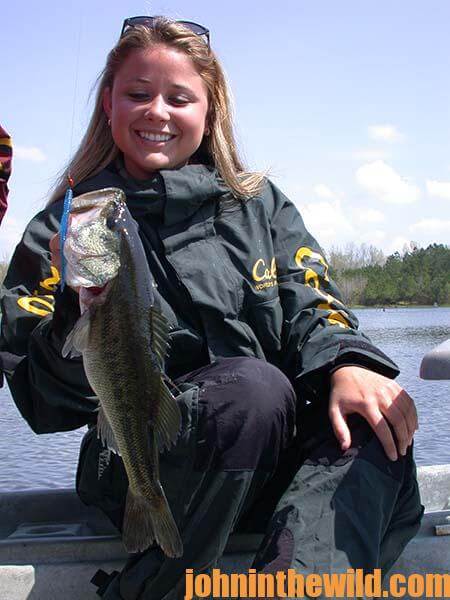 “Most falling-water conditions occur in the late summer and fall. The bass should be aggressive during these seasons. I try and cover a lot of bottom with fast retrieves. I will crank-down to the bottom and then use a fast, stop-and-go retrieve trying to dig the bait into the bottom each time I crank-down. If the bass are positioned deep on the point, you may want to use a kneel-and-reel technique of retrieve to get the bait even deeper. Expect to catch more than one bass on each point you fish. Remember that all the bass that were on brush, holding under cuts in the bank or positioned on logs and vegetation prior to the falling water have moved and concentrated along points and deeper structure. Although originally you may have caught one or two bass off of a particular point, now you may catch a limit off that same point.”
“Most falling-water conditions occur in the late summer and fall. The bass should be aggressive during these seasons. I try and cover a lot of bottom with fast retrieves. I will crank-down to the bottom and then use a fast, stop-and-go retrieve trying to dig the bait into the bottom each time I crank-down. If the bass are positioned deep on the point, you may want to use a kneel-and-reel technique of retrieve to get the bait even deeper. Expect to catch more than one bass on each point you fish. Remember that all the bass that were on brush, holding under cuts in the bank or positioned on logs and vegetation prior to the falling water have moved and concentrated along points and deeper structure. Although originally you may have caught one or two bass off of a particular point, now you may catch a limit off that same point.”
Fish Downed Trees:
“Another area you can bet on to find bass when the water is falling is a downed tree,” Clunn reports. “If the stump is in shallow water, and the top is in deep water, you may locate a good concentration of bass right out on the end of the tree closest to deep water. Those treetop bass will be extremely aggressive. The competition for food is much greater when the water is falling than it has been before the pool has been lowered. This situation is much like a family planning to have Sunday dinner together. Then all of a sudden an uncle and aunt with six or more kids arrive, and they too sit-down to dinner. The little hands go to grabbing the chicken as soon as it comes by to make sure they get some before it runs out. Concentrated bass, when the water is falling, compete for food in much the same way. When angling fallen treetops, I still fish my crankbait on the deep end of the tree. I also will expect to take two to five bass off of that tree before I leave it. However, remember when fishing treetops that a tree must be lying out close to a ledge or a creek channel drop-off to really be productive. Even though a treetop will provide cover, bass won’t use it, unless it’s located close to deep water. Bass will trade cover and food for the security of depth.”
“Creeks that have large, shallow-water flats in them are other productive places to fish during low water,” Clunn explains. “When the water falls, and the flats are exposed, the only place for all those shallow-water bass to be is in the creek channel. Now that you know where the bass are located close to the flats, all you have to do is catch them. Cast as shallow as you can, and come off the underwater bank into the creek channel. The bass should be waiting there. Spinner baits, worms and the pig and jig all will produce under this condition. Once I find a group of bass concentrated, I have two tactics I use to catch them. First, I will utilize the crankbait to locate the bass and catch the most-aggressive fish in the school. When the bass stop biting, I will change to either a pig and jig or a worm as a mop-up bait. With those two baits, you often can take the bigger, less-aggressive bass that may be in the school but that won’t hit the crankbait. If you only want to catch the big bass out of the school, use a big crankbait and/or a big pig and jig.”
To get “Hot-Weather Bass Tactics,” “How to Become a Tournament Bass Fisherman,” “How to Win a Bass Tournament: Personal Lessons from 8 Pro Bass Fishermen,” “Catch the Most and Biggest Bass in Any Lake: 18 Pro Fishermen’s Best Tactics” and “How to Bass Fish Like a Pro,” click here to get these books.
About the Author
John Phillips, winner of the 2012 Homer Circle Fishing Award for outstanding fishing writer by the American Sportfishing Association (AMA) and the Professional Outdoor Media Association (POMA), the 2008 Crossbow Communicator of the year and the 2007 Legendary Communicator chosen for induction into the National Fresh Water Hall of Fame, is a freelance writer (over 6,000 magazine articles for about 100 magazines and several thousand newspaper columns published), magazine editor, photographer for print media as well as industry catalogues (over 25,000 photos published), lecturer, outdoor consultant, marketing consultant, book author and daily internet content provider with an overview of the outdoors. Click here for more information and a list of all the books available from John E. Phillips.

